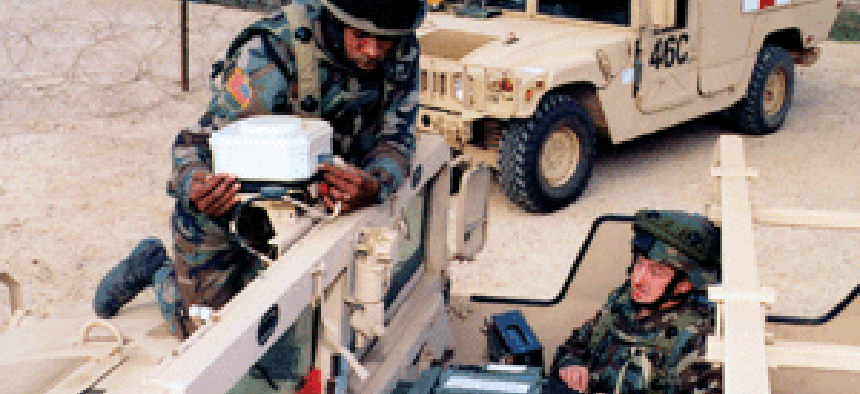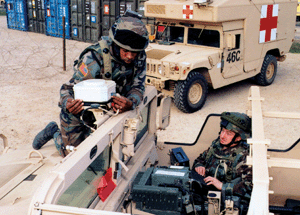Resupply on the fly

On the battlefield, even the best laid plans may need to be changed in an instant. A routine scouting mission can turn into a firefight, leaving a unit of soldiers low on fuel, ammunition or other supplies.
On the battlefield, even the best laid plans may need to be changed in an instant. A routine scouting mission can turn into a firefight, leaving a unit of soldiers low on fuel, ammunition or other supplies.It is then that the field of logistics drops its usually humdrum image and springs into action to deliver those vitally important supplies to warfighters.And that kind of circumstance is the reason the Army is implementing the second generation of its Movement Tracking System, a technology solution that lets commanders keep track of truck convoys and the supplies they're carrying, said Dallas Linke, senior vice president of programs at Comtech Mobile Datacom Corp., which developed and produces the system."It allows for vehicle-tracking worldwide using L-band satellite communications capabilities to enable the safe movement of these vehicles, primarily in hostile areas," Linke said.Comtech developed the technology for civilian applications, but it has since modified and adapted it for military use. Today, the technology is used almost exclusively by the military.The movement-tracking system is similar to but separate from Blue Force Tracking, which lets military leaders track friendly and enemy forces.Army officials became interested in the movement-tracking system because the previous method was antiquated and low tech, said Lt. Col. Jeannette Jones, the Army's product manager for the system."I've been in the logistics community basically my entire career, since 1983, and the way we used to track visibility of things like convoys and assets on the road was basically through radios," Jones said. "And in the logistics community we never had enough radios, so it's not like we had one per vehicle."To close that communications gap, the Army in 2003 started developing a commercial product to create the system it needed. The basic requirement was a tool that could provide communications and in-transit visibility while trucks and supplies were moving along a road anywhere in the world.The system uses the Global Positioning System and has two-way messaging for communications between trucks and commanders.The Army uses the system primarily for logistics, but it also uses it during the mission for command and control."By virtue of that two-way messaging and its mapping capabilities, the logistics command and control stations can see where their vehicles are during a mission," Jones said. "The logistics commanders get better command and control of their vehicles, their convoys and also the assets distribution and redistribution to support the warfighter."The Movement Tracking System's data is shared with the Blue Force Tracking systems to give those commanders full situational awareness of what's happening on the battlefield.In a war zone, logistics quickly can become complex. Often convoys comprise vehicles from different units, and the supplies they're carrying can be fuel, food, repair parts -- anything needed to support warfighters.In a typical convoy of 10 to 12 vehicles, not every vehicle would have the system installed. While on a mission, vehicles that have the system can message back and forth with one another, as well as with commanders stationed at a control center miles away. The system's mapping features ensure the convoy doesn't get lost.If the convoy comes upon an obstacle or problem, group messaging can be used to figure out the next move."Let's say the convoy is going down a road and they come into a firefight -- they can use that two-way messaging not only to tell the rest of the convoy they're in trouble, but also they can message headquarters," Jones said. "There have been some incidents where that has occurred. There have been distress messages sent forward, and we believe the system saved the lives of the logistics soldiers in these convoys."Soldiers in the trucks access the system via ruggedized laptops. Making all of the system's components rugged was the biggest challenge in modifying the system for military use, Linke said.The system's control center lets commanders see the vehicles on a map and communicate with them.The second generation of tracking systems now going into trucks includes radio frequency identification capabilities, Linke said.The addition of RFID makes it easier to redistribute supplies on the fly. For example, if a convoy is going down the road on a mission to deliver fuel and a nearby infantry unit comes under attack, the convoy can be redirected to supply the infantry unit after the firefight. "That's something we were never able to do efficiently and quickly before," Jones said. "We just didn't have the communications or mapping or the data to do that and redirect a convoy safely."The new system also has a panic button soldiers can use when trouble arises to send out a group message with a distress signal. That feature came from the request of soldiers in the field, Jones said."Soldiers believe this system has literally saved their lives in some instances," she said. "With the two-way messaging and the alert capability, they were able to get help in distress situations. Who knows what would have happened if they had not gotten that help?"Staff Writer Doug Beizer can be reached at dbeizer@postnewsweektech.com.


Soldiers check out the Movement Tracking System motor pool.
Photo courtesy PM Logistics Information Systems
NEXT STORY: On the edge

